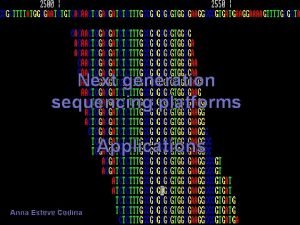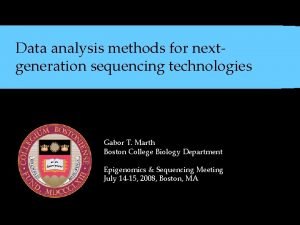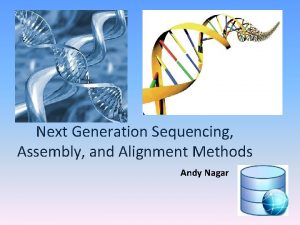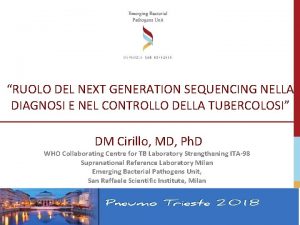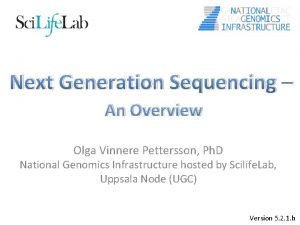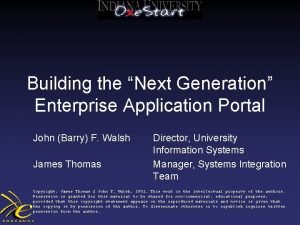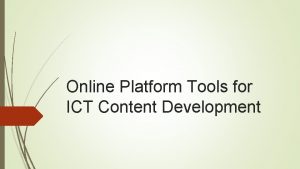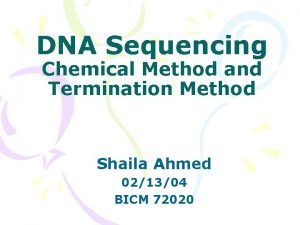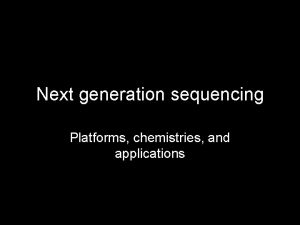Next generation sequencing platforms Applications Anna Esteve Codina



















- Slides: 19

Next generation sequencing platforms Applications Anna Esteve Codina

Sanger vs NGS ‘Sanger sequencing’ has been the only DNA sequencing method for 30 years but… …hunger for even greater sequencing throughput and more economical sequencing technology… NGS has the ability to process millions of sequence reads in parallel rather than 96 at a time (1/6 of the cost) Objections: fidelity, read length, infrastructure cost, handle large volum of data.

Sequencing of the human genome Public Consortium • • • Many years of hard work More than 20. 000 BAC clones Each containing about 100 kb fragment Together provided a tiling path through each human chromosome Amplification in bacterial culture Isolation, select pieces about 2 -3 kb Subcloned into plasmid vectors, amplification, isolation recreate contigs Refinement, gap closure, sequence quality improvement (less 1 error/ 40. 000 bases) BAC based approaches toward WGS

Platforms • • • Roche/454 FLX: 2004 Illumina Solexa Genome Analyzer: 2006 Applied Biosystems SOLi. DTM System: 2007 Helicos Heliscope. TM : recently available Pacific Biosciencies SMRT: launching 2010

Roche 454 technology

Illumina Solexa


454 vs Solexa • • • Homopolymers (AAAAA. . ) Read length: 400 bp Number of reads: 400. 000 Per-base cost greater Novo assembly, metagenomics Read length: 40 bp Number of reads: millions Per-base cost cheaper Ideal for application requiring short reads: nc. RNA

• • • • Applications Ancient DNA mixtures from diverse ecosystems, metagenomics Resequencing previously published reference strains Identification of all mutations in an organism Errors in published literature Expand the number of available genomes Comparative studies Deciphering cell’s transcripts at sequence level without knowledge of the genome sequence Sequencing extremely large genomes, crop plants Detection of cancer specific alleles avoiding traditional cloning Chip-seq: interactions protein-DNA Epigenomics Detecting nc. RNA Genetic human variation : SNP, CNV (diseases)

Ancient Genomes Resurrected • Degraded state of the sample mit. DNA sequencing • Nuclear genomes of ancient remains: cave bear, mommoth, Neanderthal (106 bp ) Problems: contamination modern humans and coisolation bacterial

Elucidating DNA-protein interactions through chromoatin immunoprecipitation sequencing • Key part in regulating gene expression • Chip: technique to study DNA -protein interaccions • Recently genome-wide Ch. IPbased studies of DNA-protein interactions • Readout of Ch. IP-derived DNA sequences onto NGS platforms • Insights into transcription factor/histone binding sites in the human genome • Enhance our understanding of the gene expression in the context of specific environmental stimuli

Discovering noncoding RNAs • nc. RNA presence in genome difficult to predict by computational methods with high certainty because the evolutionary diversity • Detecting expression level changes that correlate with changes in environmental factors, with disease onset and progression, complex disease set or severity • Enhance the annotation of sequenced genomes (impact of mutations more interpretable)

Mutation discovery • Extreme example: multiplexing the amplification of 10 000 human exons using primers from a programmable microarray and sequencing them using NGS.

Metagenomics • Characterizing the biodiversity found on Earth • The growing number of sequenced genomes enables us to interpret partial sequences obtained by direct sampling of specif environmental niches. • Examples: ocean, acid mine site, soil, coral reefs, human microbiome which may vary according to the health status of the individual

Defining variability in many human genomes • Common variants have not yet completly explained complex disease genetics rare alleles also contribute • Also structural variants, large and small insertions and deletions • Accelerating biomedical research

Epigenomic variation • Enable of genome-wide patterns of methylation and how this patterns change through the course of an organism’s development. • Enhanced potential to combine the results of different experiments, correlative analyses of genomewide methylation, histone binding patterns and gene expression, for example.

More about epigenetics… • Epigenetics: beyond the sequence. "The major problem, I think, is chromatin. What determines whether a given piece of DNA along the chromosome is functioning, since it's covered with the histones? What is happening at the level of methylation and epigenetics? You can inherit something beyond the DNA sequence. That's where the real excitement of genetics is now. " (James D. Watson). Chromatin is defined as the dynamic complex of DNA and histone proteins that makes up chromosomes. • Epigenetics is defined as the chemical modification of DNA that affects gene expression but does not involve changes to the underlying DNA sequence. As the emphasis in biology is switching away from genetic sequence and towards the mechanisms by which gene activity is controlled, epigenetics is becoming increasingly popular. Epigenetic processes are essential for packaging and interpreting the genome, are fundamental to normal development and are increasingly recognized as being involved in human disease. Epigenetic mechanisms include, among other things, histone modification, positioning of histone variants, nucleosome remodelling, DNA methylation, small and non-coding RNAs. (Nature, 7 Aug 2008).

Technology improvements • Reduced sequencing error • Increment read length • Developing new bioinformatic tools Align: MAQ, SOAP Assembly: SSAKE Base caller: Pyro. Bayes Variant detection: MAQ, GEM • Cost reduction: 1000$ for personal genomics

Bibliografia • Schuster 2008. Next-generation sequencing transforms today’s biology. Nature Methods - 5, 16 - 18 (2008). Published online: 19 December 2007; | doi: 10. 1038/nmeth 1156. • Mardis ER. 2008. Next-generation DNA sequencing methods. Annu Rev Genomics Hum Genet. 2008; 9: 387 -402. Review. • Mardis ER. 2008. The impact of next-generation sequencing technology on genetics. Trends Genet. 2008 Mar; 24(3): 133 -41. Epub 2008 Feb 11. Review. • Shendure and Ji. 2008 Next-generation DNA sequencing. Nat Biotechnol. 2008 Oct; 26(10): 1135 -45. • Wheeler DA et al. 2008. The complete genome of an individual by massively parallel DBA sequencing. Nature. 2008 Apr 17; 452(7189): 872 -6.
 Esteve codina
Esteve codina Next generation sequencing methods
Next generation sequencing methods Next generation sequencing
Next generation sequencing Mic next generation sequencing
Mic next generation sequencing Olga v. pettersson
Olga v. pettersson X.next = x.next.next
X.next = x.next.next Onestart.iu.edu
Onestart.iu.edu 3rd generation dna sequencing
3rd generation dna sequencing Security strategies in linux platforms and applications
Security strategies in linux platforms and applications Security strategies in linux platforms and applications
Security strategies in linux platforms and applications Online ict content tools
Online ict content tools Security strategies in windows platforms and applications
Security strategies in windows platforms and applications Security strategies in windows platforms and applications
Security strategies in windows platforms and applications Security strategies in windows platforms and applications
Security strategies in windows platforms and applications Dna sequencing applications
Dna sequencing applications Escola josep ferra i esteve
Escola josep ferra i esteve Jessica esteve
Jessica esteve Salvador vila esteve
Salvador vila esteve Alexandra esteve
Alexandra esteve First generation antipsychotics
First generation antipsychotics
